Monitoring and Assessment of the Oasis Ecological Resilience Improved by Rational Water Dispatching Using Multiple Remote Sensing Data: A Case Study of the Heihe River Basin, Silk Road
Abstract
1. Introduction
2. Materials and Methods
2.1. Study Area
2.2. Processing of Landsat Data for Desertification Assessment
2.3. Indicative Index and Decision Tree for Desertification Assessment
2.4. Meteorological, Hydrological and Water Utilization Data
2.5. Spatio-Temporal Analyses of Meteorological Data
2.6. Water Balance between Downstream and Midstream
3. Results
3.1. Spatio-Temporal Variations in HRDB Ecological Environment from 1990 to 2015
3.2. Spatio-Temporal Changes in the HRDB’s Climate Since Water Dispatching was Implemented in 2000
3.3. Water Thresholds for Runoff Allocation along the Heihe River basin
4. Discussion
5. Conclusions
Supplementary Materials
Author Contributions
Funding
Acknowledgments
Conflicts of Interest
References
- Immerzeel, W.W.; van Beek, L.P.H.; Bierkens, M.F.P. Climate change will affect the asian water towers. Science 2010, 328, 1382–1385. [Google Scholar] [CrossRef] [PubMed]
- Gunderson, L.H. Ecological resilience—In theory and application. Annu. Rev. Ecol. Syst. 2000, 31, 425–439. [Google Scholar] [CrossRef]
- Reynolds, J.F.; Smith, D.M.; Lambin, E.F.; Turner, B.L., II; Mortimore, M.; Batterbury, S.P.; Downing, T.E.; Dowlatabadi, H.; Fernandez, R.J.; Herrick, J.E.; et al. Global desertification: Building a science for dryland development. Science 2007, 316, 847–851. [Google Scholar] [CrossRef]
- Ascensão, F.; Fahrig, L.; Clevenger, A.P.; Corlett, R.T.; Jaeger, J.A.G.; Laurance, W.F.; Pereira, H.M. Environmental challenges for the belt and road initiative. Nat. Sustain. 2018, 1, 206–209. [Google Scholar] [CrossRef]
- Immerzeel, W.W.; Lutz, A.F.; Andrade, M.; Bahl, A.; Biemans, H.; Bolch, T.; Hyde, S.; Brumby, S.; Davies, B.J.; Elmore, A.C.; et al. Importance and vulnerability of the world’s water towers. Nature 2019. [Google Scholar] [CrossRef] [PubMed]
- Micklin, P. The aral sea disaster. Annu. Rev. Earth Planet. Sci. 2007, 35, 47–72. [Google Scholar] [CrossRef]
- Gong, J.D.; Dong, G.R.; Li, S.; Gao, S.Y. Degeneration of physical environment and its control in Ejin oasis at the lower reaches of Heihe River. J. Desert Res. 1988, 18, 44–50. (In Chinese) [Google Scholar] [CrossRef]
- Cheng, G.; Li, X.; Zhao, W.; Xu, Z.; Feng, Q.; Xiao, S.; Xiao, H. Integrated study of the water–ecosystem–economy in the Heihe River Basin. Natl. Sci. Rev. 2014, 1, 413–428. [Google Scholar] [CrossRef]
- Chen, R.; Wang, G.; Yang, Y.; Liu, J.; Han, C.; Song, Y.; Liu, Z.; Kang, E. Effects of cryospheric change on alpine hydrology: Combining a model with observations in the upper reaches of the Hei River, China. J. Geophys. Res. Atmos. 2018, 123, 3414–3442. [Google Scholar] [CrossRef]
- Chen, D.J.; Xu, Z.M.; Chen, R.S. Design of resources accounts: A case of integrated environmental and economic accounting. Adv. Water Sci. 2003, 14, 631–637. [Google Scholar] [CrossRef]
- Jin, X.M.; Schaepman, M.; Clevers, J.; Su, Z.; Hu, G. Correlation between annual runoff in the Heihe River to the vegetation cover in the Ejina Oasis (China). Arid Land Res. Manag. 2010, 24, 31–41. [Google Scholar] [CrossRef]
- Hochmuth, H.; Thevs, N.; He, P. Water allocation and water consumption of irrigation agriculture and natural vegetation in the Heihe River watershed, NW China. Environ. Earth Sci. 2014, 73, 5269–5279. [Google Scholar] [CrossRef]
- Jin, X.M.; Schaepman, M.E.; Clevers, J.G.P.W.; Su, Z.B.; Hu, G.C. Groundwater depth and vegetation in the Ejina area, China. Arid Land Res. Manag. 2011, 25, 194–199. [Google Scholar] [CrossRef]
- Chen, X.L. The ecological water dispatching in the Heihe River from 2000 to 2004. J. Arid Land Res. Environ. 2006, 20, 104–108. (In Chinese) [Google Scholar] [CrossRef]
- Si, J.H.; Feng, Q.; Zhang, X.Y. Vegetation changes in the lower reaches of the Heihe River after its water import. Acta BotBoreal-Occident. 2005, 25, 631–640. (In Chinese) [Google Scholar]
- Guo, Q.L.; Feng, Q.; Li, J. Environmental changes after ecological water conveyance in the lower reaches of Heihe River, northwest China. Environ. Geol. 2009, 58, 1387–1396. [Google Scholar] [CrossRef]
- Niu, Z.R.; Zhao, W.Z.; Huang, W.D. Impact of ecological water diversion on temporal and spatial change of water resources in Heihe downstream. J. China Hydrol. 2011, 31, 52–56. [Google Scholar] [CrossRef]
- Wang, X.P.; Tang, D.S.; Xue, F. Post-evaluation of the ecological effects of recent management in the downstream of Heihe River based on fuzzy matterelement. YellowRiver 2012, 32, 7009–7017. [Google Scholar] [CrossRef][Green Version]
- Elkington, J. Enter the triple bottom Line. In The Triple Bottom Line Does It All Add up? Assessing the Sustainability of Business and CSR; Henriques, A., Richardson, J., Eds.; Earthscan: London, UK, 2004. [Google Scholar]
- Guo, Q.; Fu, B.H.; Shi, P.L.; Cudahy, T.; Zhang, J.; Xu, H. Satellite monitoring the spatial-temporal dynamics of desertification in response to climate change and human activities across the Ordos Plateau, China. Remote Sens. 2017, 9, 525. [Google Scholar] [CrossRef]
- Li, J.; Yang, X.; Jin, Y.; Yang, Z.; Huang, W.; Zhao, L.; Gao, T.; Yu, H.; Ma, H.; Qin, Z.; et al. Monitoring and analysis of grassland desertification dynamics using Landsat images in Ningxia. Remote Sens. Environ. 2013, 138, 19–26. [Google Scholar] [CrossRef]
- Wang, T.; Yan, C.Z.; Song, X.; Xie, J.L. Monitoring recent trends in the area of aeolian desertified land using Landsat images in China’s Xinjiang region. ISPRS J. Photogramm. Remote Sens. 2012, 68, 184–190. [Google Scholar] [CrossRef]
- Foody, G.M. Status of land cover classification accuracy assessment. Remote Sens. Environ. 2002, 80, 185–201. [Google Scholar] [CrossRef]
- Chen, P.; Shang, J.; Qian, B.; Jing, Q.; Liu, J. A new regionalization scheme for effective ecological restoration on the Loess Plateau in China. Remote Sens. 2017, 9, 1323. [Google Scholar] [CrossRef]
- Liu, Q.; Zhang, Q.; Yan, Y.; Zhang, X.; Niu, J.; Svenning, J.C. Ecological restoration is the dominant driver of the recent reversal of desertification in the Mu Us Desert (China). J. Clean. Prod. 2020, 268, 122241. [Google Scholar] [CrossRef]
- Collado, A.D.; Chuvieco, E.; Camarasa, A. Satellite remote sensing analysis to monitor desertification processes in the crop-rangeland boundary of Argentina. J. Arid Environ. 2002, 52, 121–133. [Google Scholar] [CrossRef]
- Geerken, R.; Ilaiwi, M. Assessment of rangeland degradation and development of a strategy for rehabilitation. Remote Sens. Environ. 2004, 90, 490–504. [Google Scholar] [CrossRef]
- Prince, S.D.; Wessels, K.J.; Tucker, C.J.; Nicholson, S.E. Desertification in the Sahel: A reinterpretation of a reinterpretation. Glob. Chang. Biol. 2007, 13, 1308–1313. [Google Scholar] [CrossRef]
- Dubovyk, O.; Menz, G.; Conrad, C.; Kan, E.; Machwitz, M.; Khamzina, A. Spatio-temporal analyses of cropland degradation in the irrigated lowlands of Uzbekistan using remote-sensing and logistic regression modeling. Environ. Monit. Assess. 2012, 185, 4775–4790. [Google Scholar] [CrossRef]
- Paolo, D.O.; Abinash, B.; Kyle, F.D.; Sujith, R.; Runyan, C.W. Global desertification: Drivers and feedbacks. Adv. Water Resour. 2013, 51, 326–344. [Google Scholar] [CrossRef]
- Yang, Y.M.; Feng, Z.D.; Zhou, J. Evapotranspiration in Heihe River Basin base on SEBS model. J. Lanzhou Univ. (Nat. Sci.) 2008, 44, 1–6. (In Chinese) [Google Scholar]
- Guo, Q.; Yang, Y.; Chen, Z. Remote sensing monitoring vegetation cover change in Ejina Oasis after Heihe river water was distributed. J. Water Resour. Water Eng. 2010, 21, 65–66. (In Chinese) [Google Scholar]
- Zhang, Y.; Yu, J.; Wang, P.; Fu, G. Vegetation responses to integrated water management in the Ejina basin, northwest China. Hydrol. Process. 2011, 25, 3448–3461. [Google Scholar] [CrossRef]
- Yu, J.; Wang, P. Relationship between water and vegetation in the Ejina delta. Bull. Chin. Acad. Sci. 2012, 26, 68–75. [Google Scholar] [CrossRef]
- Yan, Y.H.; Xue, B.L.; Zhang, L.F.; Li, Z.J. Temporal and spatial distribution characteristics of evapotranspiration in the Heihe river basin based on MOD16 Product. Water Sav. Irrig. 2019, 9, 85–92. (In Chinese) [Google Scholar]
- Symeonakis, E.; Drake, N. Monitoring desertification and land degradation over sub-Saharan Africa. Int. J. Remote Sens. 2004, 25, 573–592. [Google Scholar] [CrossRef]
- Feng, X.; Fu, B.; Piao, S.; Wang, S.; Ciais, P.; Zeng, Z.; Lü, Y.; Zeng, Y.; Li, Y.; Jiang, X.; et al. Revegetation in China’s Loess Plateau is approaching sustainable water resource limits. Nat. Clim. Chang. 2016, 6, 1019–1022. [Google Scholar] [CrossRef]
- Elmore, A.J.; Mustard, J.F.; Manning, S.J.; Lobell, D.B. Quantifying vegetation change in semiarid environments: Precision and accuracy of spectral mixture analysis and the Normalized Difference Vegetation Index. Remote Sens. Environ. 2000, 73, 87–102. [Google Scholar] [CrossRef]
- Dawelbait, M.; Morari, F. Monitoring desertification in a Savannah region in Sudan using Landsat images and spectral mixture analysis. J. Arid Environ. 2012, 80, 45–55. [Google Scholar] [CrossRef]
- Wessels, K.; Prince, S.; Frost, P.; van Zyl, D. Assessing the effects of human-induced land degradation in the former homelands of northern South Africa with a 1 km AVHRR NDVI time-series. Remote Sens. Environ. 2004, 91, 47–67. [Google Scholar] [CrossRef]
- Qi, J.; Chehbouni, A.; Huete, A.R.; Kerr, Y.H.; Sorooshian, S. A modified soil adjusted vegetation index. Remote Sens. Environ. 1994, 48, 119–126. [Google Scholar] [CrossRef]
- Xu, H.Q. A study on information extraction of water body with the modified normalized difference water index (MNDWI). J. Remote Sens. 2005, 9, 589–595. (In Chinese) [Google Scholar] [CrossRef]
- Rikimaru, A.; Roy, S.P.; Miyatake, S. Tropical forest cover density mapping. Trop. Ecol. 2002, 43, 39–47. [Google Scholar]
- Friedl, M.A.; Brodley, C.E.; Strahler, A.H. Maximizing land cover classification accuracies produced by decision trees at continental to global scales. IEEE Trans. Geosci. Remote Sens. 1999, 37, 969–977. [Google Scholar] [CrossRef]
- Lamchin, M.; Lee, J.Y.; Lee, W.K.; Lee, E.J.; Kim, M.; Lim, C.H.; Choi, H.A.; Kim, S.-R. Assessment of land cover change and desertification using remote sensing technology in a local region of Mongolia. Adavances Space Res. 2016, 57, 64–77. [Google Scholar] [CrossRef]
- Rogan, J.; Franklin, J.; Roberts, D.A. A comparison of methods for monitoring multitemporal vegetation change using Thematic Mapper imagery. Remote Sens. Environ. 2002, 80, 143–156. [Google Scholar] [CrossRef]
- Zhu, Z.D. Fragile ecological zones and land desertification in China. J. Desert Res. 1991, 11, 11–22. (In Chinese) [Google Scholar]
- Wang, T.; Wu, W.; Xue, X.; Sun, Q.W.; Chen, G.T. Study of spatial distribution of sandy desertification in North China in recent 10 years. Sci. China 2004, 47, 78–88. [Google Scholar] [CrossRef]
- Abatzoglou, J.T.; Dobrowski, S.Z.; Parks, S.A.; Hegewisch, K.C. TerraClimate, a high-resolution global dataset of monthly climate and climatic water balance from 1958–2015. Sci. Data 2018, 5, 170191. [Google Scholar] [CrossRef]
- Wu, T.; Li, Y. Spatial interpolation of temperature in the United States using residual kriging. Appl. Geogr. 2013, 44, 112–120. [Google Scholar] [CrossRef]
- Aalto, J.; Pirinen, P.; Heikkinen, J.; Venäläinen, A. Spatial interpolation of monthly climate data for Finland: Comparison the performance of kriging and generalized additive models. Theor. Appl. Climatol. 2013, 112, 99–111. [Google Scholar] [CrossRef]
- Chen, H.; Guo, S.L.; Xu, C.Y.; Singh, V.P. Historical temporal trends of hydro-climatic variables and runoff response to climate variability and their relevance in water resource management in the Hanjiang Basin. J. Hydrol. 2007, 344, 171–184. [Google Scholar] [CrossRef]
- Fathian, F.; Dehghan, Z.; Bazrkar, M.H.; Saeid, E. Trends in hydrologic and climatic variables affected by four variations of Mann-Kendall approach in Urmia Lake basin, Iran. Hydrol. Sci. J. 2016, 61, 892–904. [Google Scholar] [CrossRef]
- Liu, B.; Zhao, W.Z.; Chang, X.X.; Li, S.B.; Zhang, Z.H.; Du, M.W. Water requirements and stability of oasis ecosystem in arid region, China. Environ. Earth Sci. 2010, 59, 1235–1244. [Google Scholar] [CrossRef]
- Zhang, L. The Study on Theory and Method of Ecological Water Demand in the Lower Reaches of Heihe River; Beijing Forestry University: Beijing, China, 2004. (In Chinese) [Google Scholar]
- Zhao, W.Z.; Liu, B.; Zhang, Z.H. Water requirements of maize in the middle Heihe River basin, China. Agric. Water Manag. 2010, 97, 215–223. [Google Scholar] [CrossRef]
- Liu, X.; Shen, Y. Water requirements of the oasis in the middle Heihe River Basin China: Trends and causes. Earth Syst. Dyn. Discuss. 2017. Manuscript under review. [Google Scholar] [CrossRef]
- Yu, T.F.; Feng, Q.; Si, J.H.; Zhang, X.Y.; Zhao, C.Y. Evapotranspiration of a Populus euphratica Oliv. forest and its controlling factors in the lower Heihe River Basin, Northwest China. Sci. Cold Arid Reg. 2017, 9, 175–182. [Google Scholar] [CrossRef]
- Zhang, G.; Xia, S.J.; Wang, S.D. Simulating the daily evapotranspiration in Heihe River Basin with multi-sensor remote sensing data. South-to-North Water Transf. Water Sci. Technol. 2018, 16, 33–38. (In Chinese) [Google Scholar] [CrossRef]
- Zhao, Y.; Wei, Y.P.; Li, S.B.; Wu, B.F. Downstream ecosystem responses to middle reach regulation of river discharge in the Heihe River Basin, China. Hydrol. Earth Syst. Sci. 2016, 20, 1–20. [Google Scholar] [CrossRef]
- Jia, L.; Shang, H.; Hu, G.; Menenti, M. Phenological response of vegetation to upstream river flow in the Heihe Rive basin by time series analysis of MODIS data. Hydrol. Earth Syst. Sci. 2011, 15, 1047–1064. [Google Scholar] [CrossRef]
- Le Houérou, H. Climate change, drought and desertification. J. Arid Environ. 1996, 34, 133–185. [Google Scholar] [CrossRef]
- Cretaux, J.F.; Kostianoy, A.; Bergé-Nguyen, M.; Kouraev, A. Present-day water balance of the Aral Sea seen from satellite. Remote Sens. Asian Seas 2018, 523–539. [Google Scholar] [CrossRef]
- Oliver, T.H.; Isaac, N.J.; August, T.A.; Woodcock, B.A.; Roy, D.B.; Bullock, J.M. Declining resilience of ecosystem functions under biodiversity loss. Nat. Commun. 2015, 6, 10122. [Google Scholar] [CrossRef] [PubMed]
- Chen, R.S.; Lu, S.H.; Kang, E.S.; Ji, X.B.; Zhang, Z.; Yang, Y.; Qing, W.W. A distributed water-heat coupled model for mountainous watershed of an inland river basin of Northwest China (I) model structure and equations. Environ. Geol. 2008, 53, 1299–1309. [Google Scholar] [CrossRef]
- Zemp, M.; Huss, M.; Thibert, E.; Eckert, N.; McNabb, R.; Huber, J.; Barandun, M.; Machguth, H.; Nussbaumer, S.U.; Gärtner-Roer, I.; et al. Global glacier mass changes and their contributions to sea-level rise from 1961 to 2016. Nature 2019, 568, 382–386. [Google Scholar] [CrossRef] [PubMed]
- Liu, H.; Chen, Y.; Ye, Z.; Li, Y.; Zhang, Q. Recent lake area changes in central asia. Sci. Rep. 2019, 9, 16277. [Google Scholar] [CrossRef]
- Krapivin, V.F.; Mkrtchyan, F.A.; Rochon, G.L. Hydrological model for sustainable development in the Aral Sea region. Hydrology 2019, 6, 91. [Google Scholar] [CrossRef]
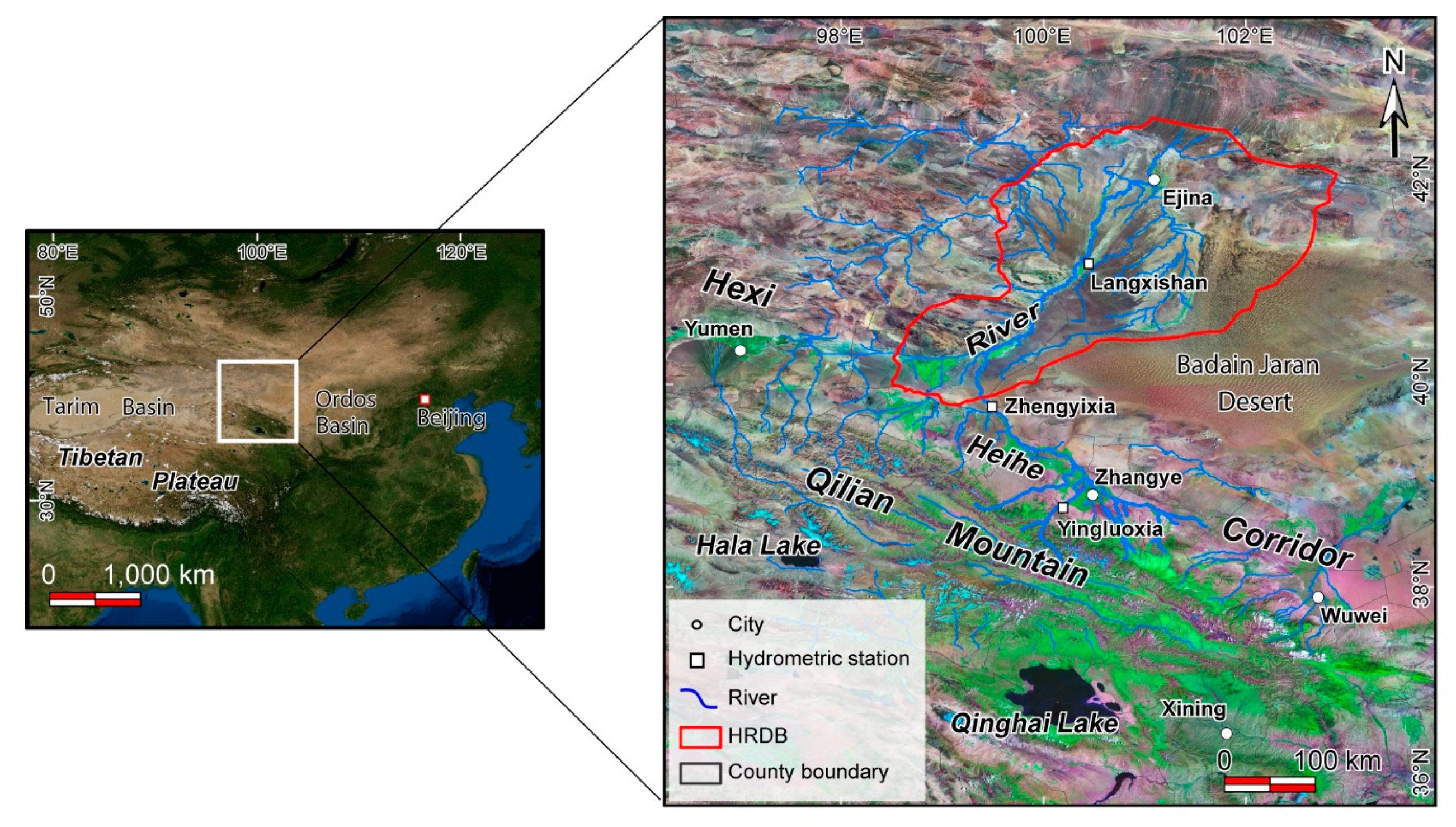
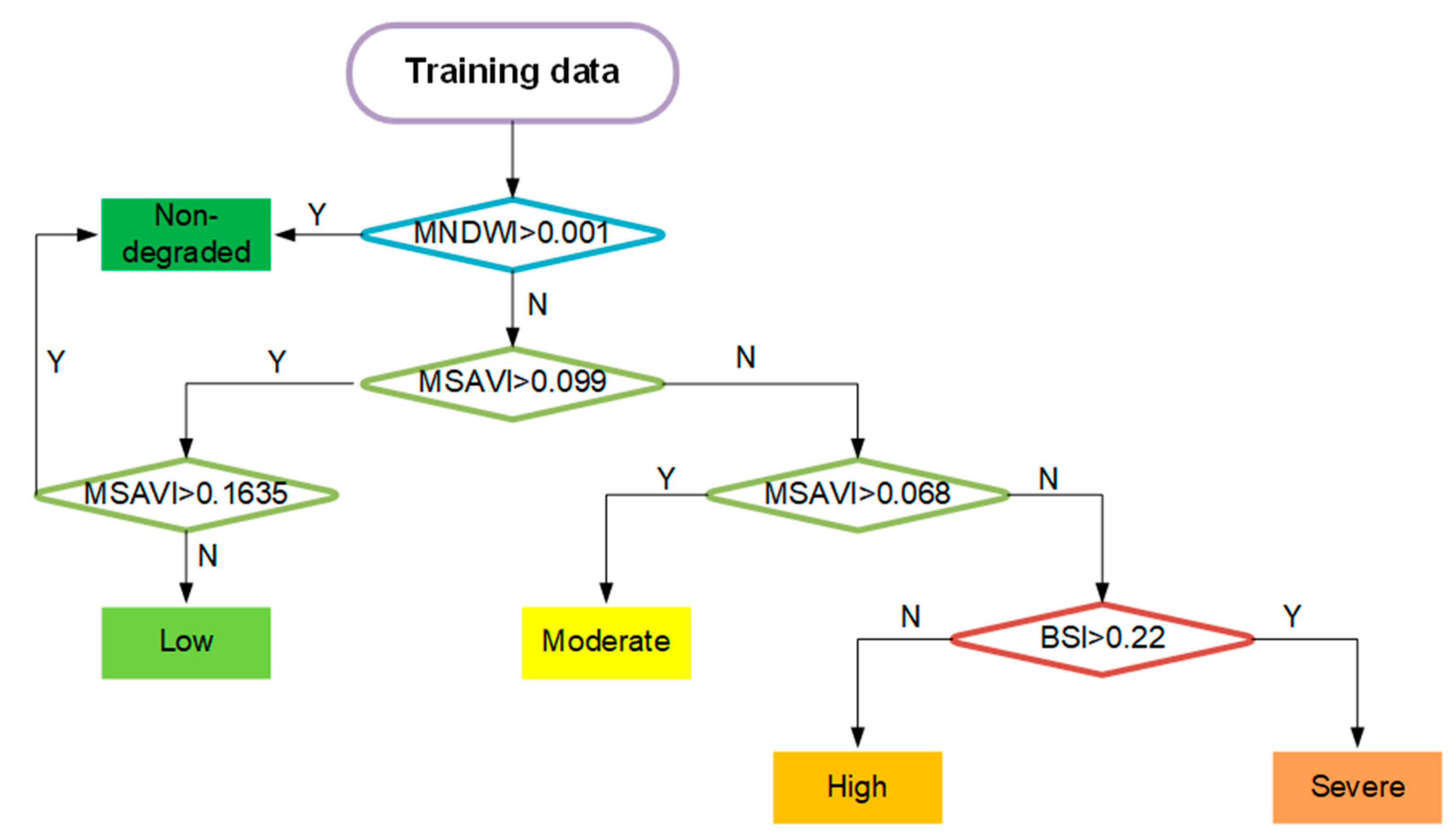
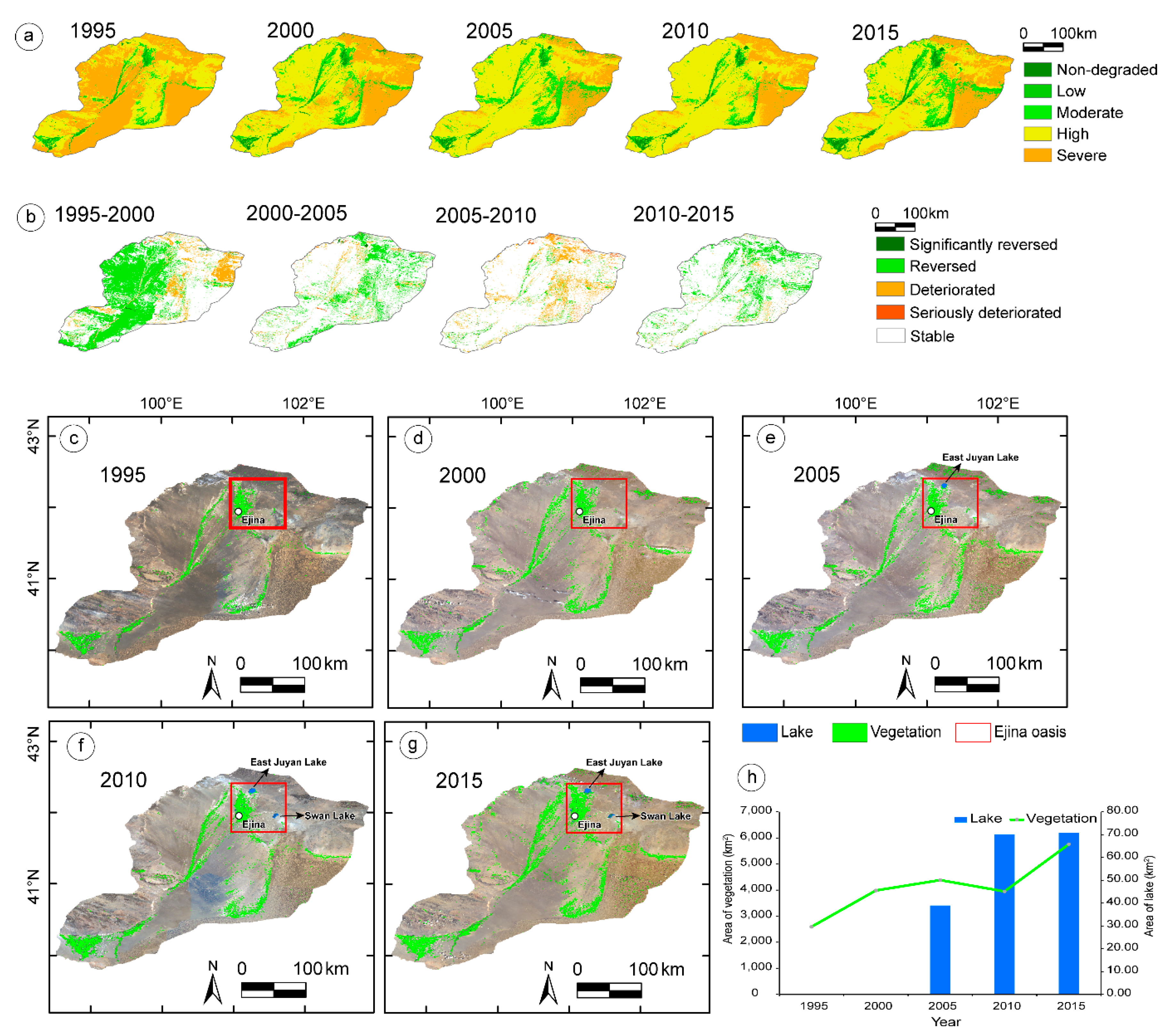
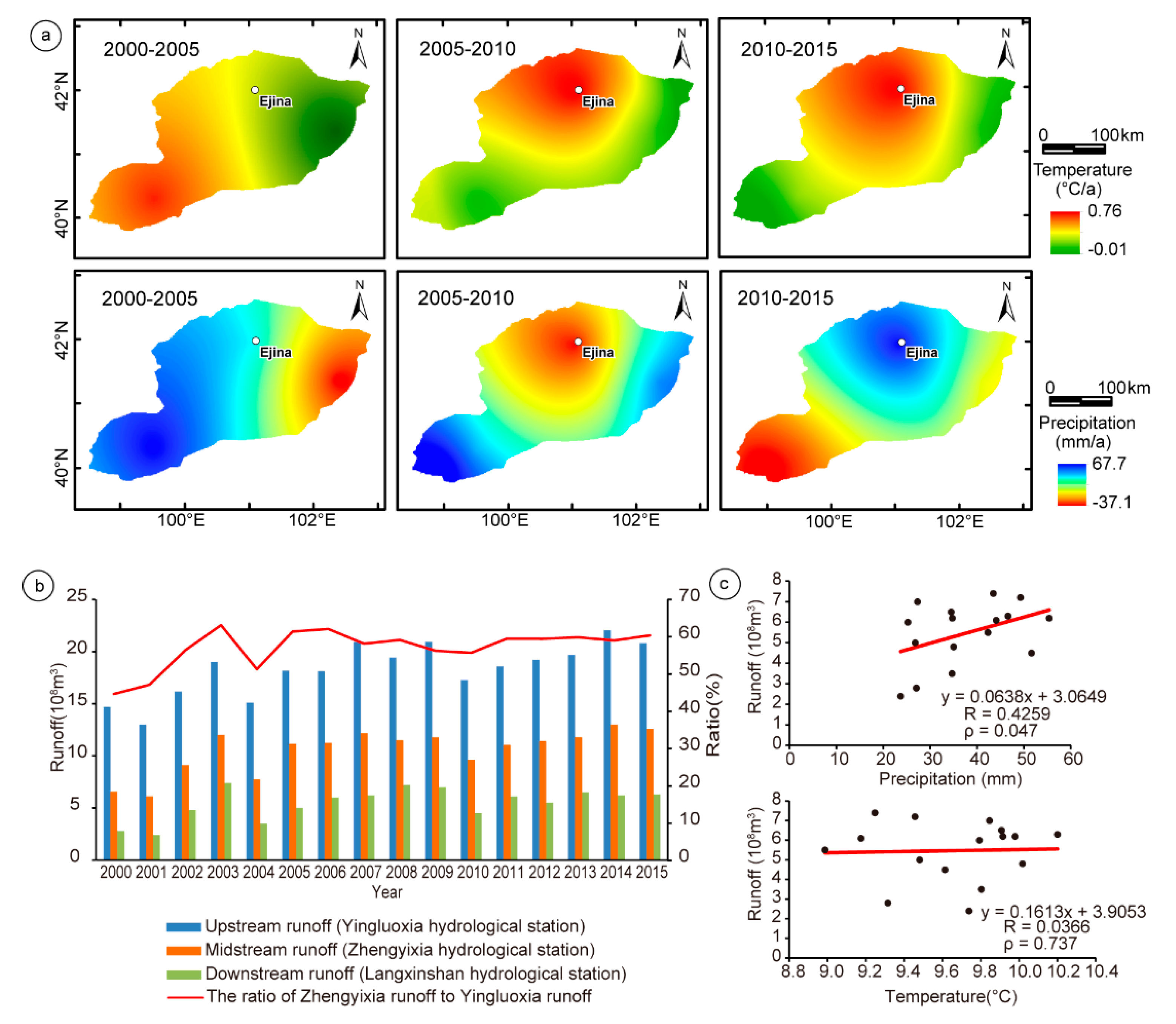
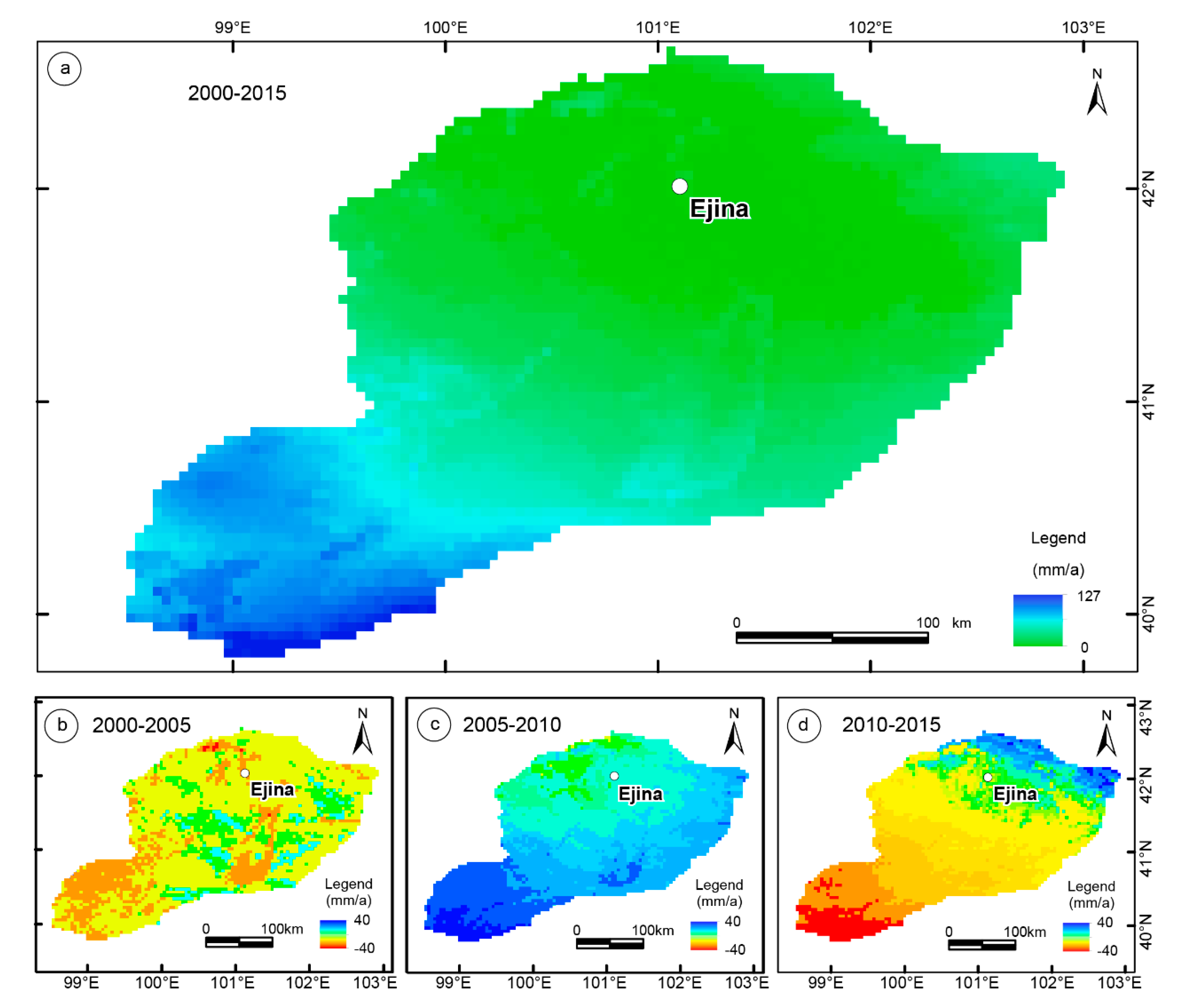

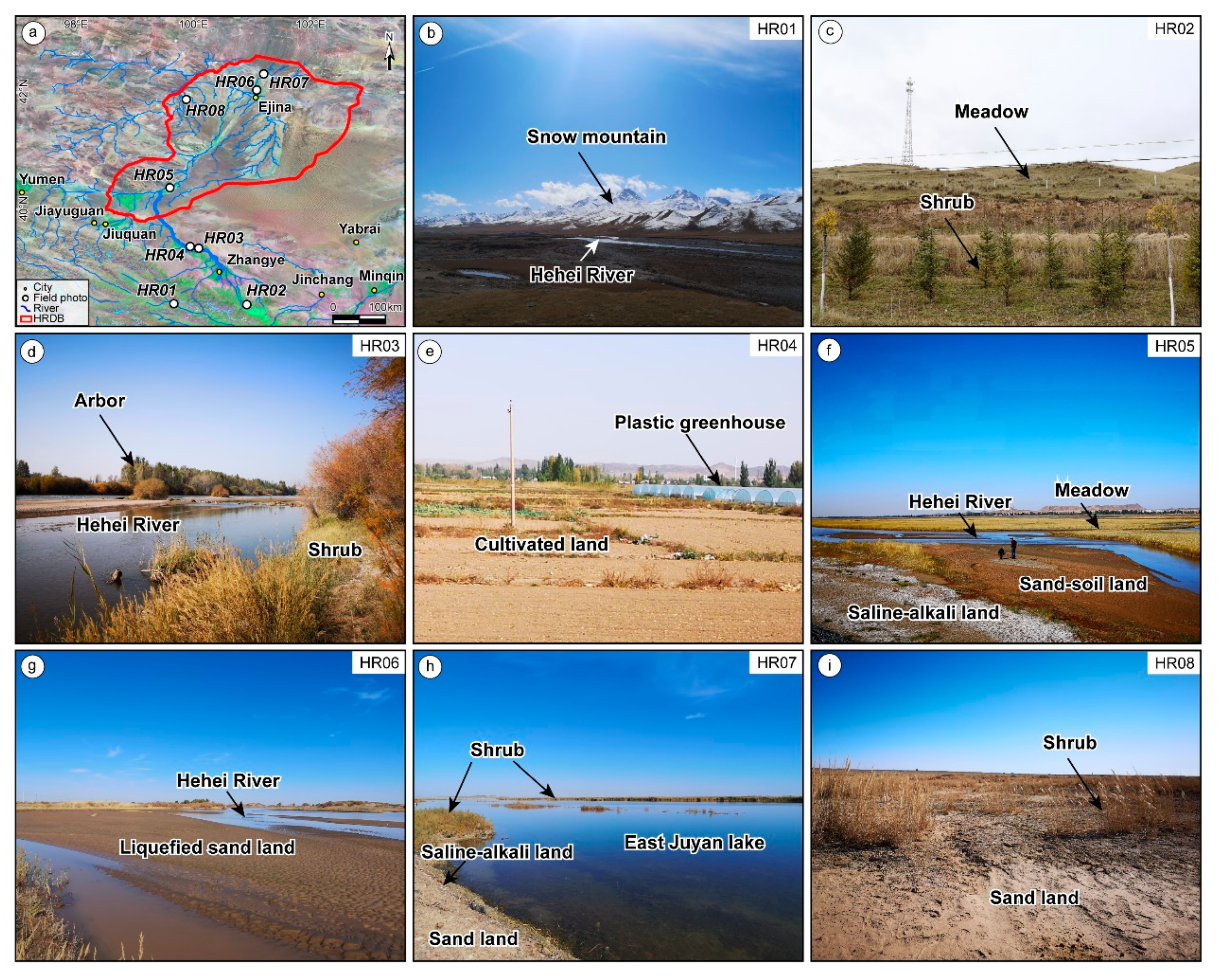

| Type | Dates | Path/Row | Spatial Resolution | Source |
|---|---|---|---|---|
| Landsat-5 TM | 19950821 | 133/31 133/32 | 30 m | USGS |
| 19950913 | 134/31 134/32 | 30 m | USGS | |
| 20000708 | 134/31 134/32 | 30 m | GDC | |
| 20000818 | 133/31 133/32 | 30 m | GDC | |
| 20050816 | 133/31 133/32 | 30 m | USGS | |
| 20050908 | 134/31 134/32 | 30 m | USGS | |
| 20100814 | 133/31 133/32 | 30 m | GDC | |
| 20100821 | 134/31 134/32 | 30 m | GDC | |
| Landsat-8 OLI | 20150718 | 134/31 134/32 | 30 m | USGS |
| 20150828 | 133/31 133/32 | 30 m | USGS |
| Desertification Degree | 1995 | 2000 | 2005 | 2010 | 2015 | |||||
|---|---|---|---|---|---|---|---|---|---|---|
| Area (km2) | % of HRDB | Area (km2) | % of HRDB | Area (km2) | % of HRDB | Area (km2) | % of HRDB | Area (km2) | % of HRDB | |
| Non-Degraded | 835.38 | 1.25 | 1465.59 | 2.20 | 1306.65 | 1.96 | 1678.70 | 2.52 | 2359.10 | 3.54 |
| Low | 1036.36 | 1.56 | 1203.17 | 1.81 | 1474.89 | 2.22 | 971.61 | 1.46 | 1851.86 | 2.78 |
| Moderate | 2550.70 | 3.83 | 4431.80 | 6.66 | 6421.46 | 9.65 | 2953.46 | 4.44 | 6011.93 | 9.03 |
| High | 24,063.91 | 36.15 | 38,222.18 | 57.41 | 44,446.15 | 66.76 | 45,156.20 | 67.83 | 44,383.14 | 66.67 |
| Severe | 38,088.54 | 57.21 | 21,252.16 | 31.92 | 12,925.75 | 19.42 | 15,814.93 | 23.76 | 11,968.87 | 17.98 |
| Overall Accuracy | 0.87 | 0.92 | 0.86 | 0.85 | 0.90 | |||||
| Desertification Degree | 1995–2000 | 2000–2005 | 2005–2010 | 2010–2015 | Total (1995–2015) | |||||
|---|---|---|---|---|---|---|---|---|---|---|
| Area (km2) | % of 1995 | Area (km2) | % of 2000 | Area (km2) | % of 2005 | Area (km2) | % of 2010 | Area (km2) | % of 1995 | |
| Non-Degraded | +630.21 | +75.44 | −158.94 | −10.84 | +372.05 | +28.47 | +680.40 | +40.53 | +1523.72 | +182.40 |
| Low | +166.81 | +16.10 | +271.72 | +22.58 | −503.28 | −34.12 | +880.25 | +90.60 | +815.50 | +78.69 |
| Moderate | +1881.10 | +73.75 | +1989.66 | +44.90 | −3468.01 | −54.01 | +3058.47 | +103.56 | +3461.23 | +135.70 |
| High | +14,158.27 | +58.84 | +6223.98 | +16.28 | +710.05 | +1.60 | −773.06 | −1.71 | +20,319.23 | +84.44 |
| Severe | −16,836.38 | −44.20 | −8326.42 | −39.18 | +2889.18 | +22.35 | −3846.06 | −24.32 | −26,119.67 | −68.58 |
| Year | Vegetation (MSAVI > 0.08) | Lakes (MNDWI > 0.8) | ||
|---|---|---|---|---|
| Area (km2) | Variation Area (km2) | Area (km2) | Variation Area (km2) | |
| 1995 | 2591.59 | 0 | 0 | 0 |
| 2000 | 3984.41 | 1392.82 | 0 | 0 |
| 2005 | 4380.84 | 396.43 | 38.93 | 38.93 |
| 2010 | 3947.32 | −433.52 | 70.13 | 31.20 |
| 2015 | 5757.40 | 1810.08 | 70.73 | 0.60 |
| Annual average increase | 158.29 | 3.54 | ||
| Year | Average ET 1 (mm/a) | Precipitation (mm/a) | Total Area (km2) | Vegetation Area (km2) | Lake Area (km2) | Industrial Water (108m3) | Domestic Water (108m3) | Water Demand (108m3) |
|---|---|---|---|---|---|---|---|---|
| 2000 | 796.69 | 27.05 | 66,574.9 | 3984.41 | 0.00 | 0.006 | 0.006 | 13.746 |
| 2005 | 611.40 | 26.80 | 66,574.9 | 4380.84 | 38.93 | 0.055 | 0.004 | 9.237 |
| 2010 | 978.2 | 51.61 | 66,574.9 | 3947.32 | 70.13 | 0.113 | 0.005 | 5.056 |
| 2015 | 850 | 46.60 | 66,574.9 | 5757.40 | 70.73 | 0.083 | 0.008 | 18.608 |
© 2020 by the authors. Licensee MDPI, Basel, Switzerland. This article is an open access article distributed under the terms and conditions of the Creative Commons Attribution (CC BY) license (http://creativecommons.org/licenses/by/4.0/).
Share and Cite
Du, J.; Fu, B.; Guo, Q.; Shi, P. Monitoring and Assessment of the Oasis Ecological Resilience Improved by Rational Water Dispatching Using Multiple Remote Sensing Data: A Case Study of the Heihe River Basin, Silk Road. Remote Sens. 2020, 12, 2577. https://doi.org/10.3390/rs12162577
Du J, Fu B, Guo Q, Shi P. Monitoring and Assessment of the Oasis Ecological Resilience Improved by Rational Water Dispatching Using Multiple Remote Sensing Data: A Case Study of the Heihe River Basin, Silk Road. Remote Sensing. 2020; 12(16):2577. https://doi.org/10.3390/rs12162577
Chicago/Turabian StyleDu, Jiaxin, Bihong Fu, Qiang Guo, and Pilong Shi. 2020. "Monitoring and Assessment of the Oasis Ecological Resilience Improved by Rational Water Dispatching Using Multiple Remote Sensing Data: A Case Study of the Heihe River Basin, Silk Road" Remote Sensing 12, no. 16: 2577. https://doi.org/10.3390/rs12162577
APA StyleDu, J., Fu, B., Guo, Q., & Shi, P. (2020). Monitoring and Assessment of the Oasis Ecological Resilience Improved by Rational Water Dispatching Using Multiple Remote Sensing Data: A Case Study of the Heihe River Basin, Silk Road. Remote Sensing, 12(16), 2577. https://doi.org/10.3390/rs12162577






